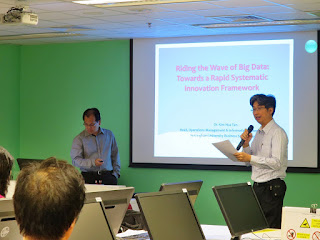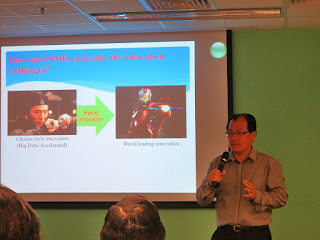(Left: Dr. Albert Tsang (HKSQ), Dr. Leanne Chung (Cardiff University), Dr. Kim Hua Tan (Nottingham University), I and Dr. Michael Li (ISIHK))
In the beginning, Dr. Albert Tsang (Former Chairman, HKSQ) introduced HKSQ background and activities as well as relationship with ASQ.
Then I introduced Dr. Kim Hua Tan to our members. He is Division Head of Operations Management and Information Systems, Nottingham University Business School, Reader in Lean Operations and Supply Management. His research interests included Operations Strategy, Sustainable Manufacturing, Performance Measurement, Lean Management, Big Data (competence sets) and Supply Chain Innovation Capabilities.
Firstly, Dr. Kim Hua Tan briefed his topics including “Why Rapid Innovation?”, “Conventional Innovation Processes”, “A Framework for Rapid Systematic Innovation” and “Further Work”. He discussed the industry crisis in China and claimed “Innovation” was the key to SMEs Competitiveness. Many challenges involved in product innovation such as “Creativity or new idea”, “Long and complex process”, “Time to market / volume” and “Huge resource and time consuming”.
Then Dr. Tan briefed different approach of Product Innovation (PI) in Japanese, Korean and China which showed in the following diagrams.
Dr. Tan used an example to turn Chinese Kung Fu to Iron Man that explained how to harvest big data to achieve rapid innovation. He reviewed conventional process from literature about systematic innovation included TRIZ, Mann’s (2004) Framework, Sheu and Lee’s (2011) Framework, Phased Program Planning (PPP) (Takeuchi and Nonaka, 1986) which endorsed by NASA and Phased Review Process (Cooper, 1994). Dr. Tan said that today’s market was fast-paced and competitive, it was necessary to speed up new product development.
Then he quoted McKinsey (2011 & 2013) “Big Data is the next frontier for innovation, competition, and productivity”. With big data, company could gain a better understanding of their products, customers, and markets, and this was crucial to innovation. He mentioned big data enhance product innovation to a higher level through “Drive incremental revenue”, “Improve operational effectiveness” and “Reduce data warehouse cost”.
Rapid Innovation Framework named ACE which was based on the principles of Accelerated Process (A), Customer Connection (C), and Ecosystem (E).
In order to achieve the Accelerated Process (A), the key elements were:
- Autonomy Management
- Cross-functional teams work in parallel
- Divides project into small elements
- Big data supported communication and development
In order to achieve the Customer Connection (C), the important elements were:
- Using big data to understand customers and market
- Keeps close to customers
- Updates the latest product information quickly
- Interact with customers and gathers useful feedback
In order to achieve the Ecosystem (E), the significant elements were:
- Builds strong networks with partners and customers
- Launches the new product quickly
- Gathers feedback quickly from customers and partners
After that Dr. Tan shared some cases included “Precision Angle and Levelling Instrument” and
“Electronic Luggage Combination Lock”, etc.
Lastly, Dr. Tan concluded accelerated innovation gave particular emphasis to efficiency and cost saving comparted with traditional innovation approaches. In addition, he pointed out some further works as follows:
- Product Innovation – end of life products
- Rapid product ramp-up capabilities
- Amazon & Ebay for fast worldwide market penetration
- Social Media – inputs for rapid product upgrades
- Wider applications in other industries
- IP Protection
Q&A Session:
At end of the seminar, Mr. Peter Fung (Chairman, HKSQ) presented a souvenir to Dr. Tan.
We had dinner with guests together in PolyU.
(Left: Mr. Karson Chui, Mr. Peter Fung, Dr. KS Chin, I, Ms. Minda Chiang, Dr. Leanne Chung, Dr. Kim Hua Tan, Mr. Simon Tong and Dr. Albert Tsang)
Reference:
HKSQ - www.hksq.org













沒有留言:
發佈留言